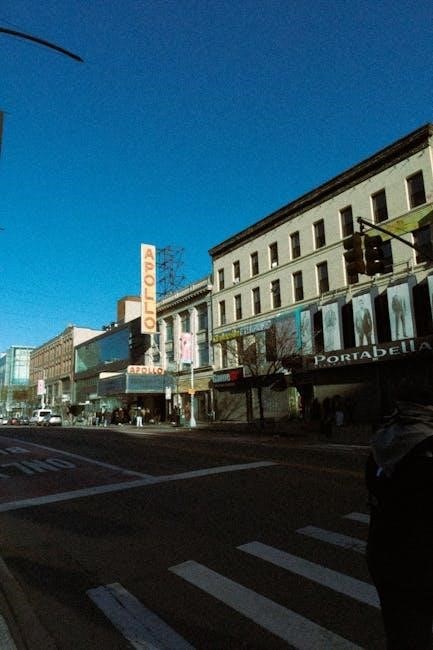Langston Hughes’s Harlem, published in 1951, explores the limitations of the American Dream for African Americans. The poem, part of Montage of a Dream Deferred, uses vivid metaphors like a raisin in the sun to depict deferred dreams, evoking frustration and urgency. Its themes of racial inequality and social justice remain deeply relevant today, making it a cornerstone of the Harlem Renaissance.
1.1 Overview of the Poem
Langston Hughes’s Harlem, published in 1951, is a poignant exploration of deferred dreams. The poem uses vivid metaphors, such as a raisin in the sun and festering sores, to depict the consequences of unfulfilled aspirations.
Its serious tone and ominous ending, which poses the question of whether deferred dreams “explode,” reflect the frustration and urgency of African Americans during the Harlem Renaissance.
1.2 Historical Context of the Harlem Renaissance
The Harlem Renaissance (1918–1930s) was a cultural and artistic movement in Harlem, New York, celebrating African American identity. It fostered a flourishing of art, literature, and music, with figures like Langston Hughes at its core. This period saw Black artists gain unprecedented freedom to express pride in their heritage and address racial inequality, shaping a legacy that continues to influence contemporary culture and social justice movements.
Themes in “Harlem”
Langston Hughes’s Harlem explores the limitations of the American Dream, racial inequality, and the concept of deferred dreams, highlighting frustration and the urgency for social change.
2.1 The American Dream and Its Limitations
Langston Hughes’s Harlem critiques the American Dream’s elusiveness for African Americans. The poem highlights how systemic barriers prevent realization of prosperity and equality, fostering disillusionment and frustration. Through metaphors like a raisin in the sun, Hughes illustrates the Dream’s decay when deferred, reflecting the struggle for racial equality and justice during the Harlem Renaissance. This theme underscores the broader societal limitations faced by African Americans in pursuit of their aspirations.
2.2 Racial Inequality and Social Justice
Langston Hughes’s Harlem addresses racial inequality by highlighting the struggles African Americans faced in pursuing equality. The poem’s metaphors, such as the raisin in the sun, symbolize the decay of hope due to systemic racism. Hughes critiques the denial of opportunities and justice, reflecting the collective frustration of a community. His work becomes a powerful call for social justice, emphasizing the need to confront and dismantle racial disparities that hinder equality and freedom.
2.3 The Concept of Deferred Dreams
Langston Hughes’s Harlem centers on the concept of deferred dreams, exploring their emotional and societal impact. Through metaphors like a raisin in the sun, Hughes illustrates how postponed aspirations lead to frustration and despair. The poem suggests that deferred dreams can fester, rot, or explode, symbolizing the consequences of unfulfilled hopes. This theme resonates deeply, highlighting the human cost of systemic barriers and the urgency of addressing them to prevent individual and collective collapse.

Symbolism and Imagery
Langston Hughes employs powerful metaphors like a raisin in the sun and rotten meat to symbolize the consequences of deferred dreams, creating vivid imagery that underscores frustration and decay.
3.1 The Raisin in the Sun as a Metaphor

The raisin in the sun metaphor in Harlem symbolizes the devastating effects of deferred dreams. A raisin, once plump and full of life, shrivels and hardens when dried, mirroring how postponed aspirations lose their vibrancy and potential. Hughes uses this imagery to convey the emotional and psychological toll of unfulfilled promises, particularly for African Americans during the Harlem Renaissance. The raisin serves as a poignant reminder of the consequences of systemic inequality and neglected opportunities.
3.2 The Sore, Rotten Meat, and Heavy Load
The sore, rotten meat, and heavy load are powerful metaphors in Harlem that illustrate the consequences of deferred dreams. The sore symbolizes pain and festering frustration, while rotten meat represents decay and corruption. The heavy load embodies the burden of unfulfilled aspirations. Together, these images evoke a sense of stagnation, despair, and potential explosiveness, highlighting the destructive nature of prolonged injustice and neglected hopes. Hughes’s vivid imagery underscores the urgency of addressing these deferred dreams before they disintegrate or erupt.
Poetic Structure and Form
Langston Hughes’s Harlem features a simple yet impactful structure, using rhetorical questions to build tension. The abrupt, ominous ending intensifies the emotional weight of deferred dreams.
4.1 Use of Rhetorical Questions
Harlem employs rhetorical questions to provoke reflection on the fate of deferred dreams. Hughes poses vivid, unsettling images—”Does it dry up like a raisin in the sun?”—to engage the reader emotionally. These questions, left unanswered, mirror the uncertainty faced by African Americans during the Harlem Renaissance, emphasizing the urgency of unresolved aspirations and fostering a deeper connection to the poem’s themes of frustration and inequality.
4.2 The Impact of the Poem’s Ending
The poem’s ending, “Or does it explode?” leaves a lasting, haunting impression. This final question emphasizes the potential consequences of deferred dreams, evoking feelings of urgency and tension. The ending challenges readers to consider the emotional and societal repercussions of unfulfilled aspirations, particularly for African Americans. Its ambiguity underscores the poem’s themes of frustration and inequality, making the conclusion both thought-provoking and deeply unsettling, while also highlighting the need for change and justice.
Critical Analysis
Critics acclaim Harlem for its vivid metaphors and explosive ending, which underscores societal tension. The poem’s exploration of deferred dreams warns of inevitable consequences, resonating deeply with its themes of racial inequality and injustice, while its simplicity and power continue to inspire scholarly and social commentary, solidifying its place in literary history.
5.1 The Poem’s Relevance to Contemporary Society
Langston Hughes’s Harlem remains powerfully relevant today, as its themes of deferred dreams and racial inequality continue to resonate. The poem’s vivid imagery, such as the raisin in the sun, reflects the frustration of unfulfilled aspirations, echoing modern struggles for social justice. Its exploration of the American Dream’s limitations speaks to ongoing disparities, making it a timeless critique of systemic inequality and a call to action for change.
5.2 The Legacy of Langston Hughes
Langston Hughes’s legacy endures as a central figure of the Harlem Renaissance, advocating for African American identity and social justice. His work transcends time, influencing art, literature, and jazz. Hughes’s home, now a museum, honors his contributions. His poetry, like Harlem, remains a powerful critique of inequality, inspiring ongoing conversations about race and justice. His impact is celebrated through educational initiatives, ensuring his voice continues to resonate in contemporary discussions of identity and cultural heritage.

Harlem as a Cultural and Historical Symbol
Harlem symbolizes African American identity, creativity, and resilience. Once a hub of the Harlem Renaissance, it represents artistic expression and racial pride, blending history with modern cultural significance.
6.1 The Harlem Renaissance’s Influence on Art and Literature
The Harlem Renaissance was a transformative cultural movement in the 1920s-30s, fostering artistic and literary growth among African Americans. It championed Black identity, creativity, and intellectual freedom, producing iconic figures like Langston Hughes. The movement flourished through literature, music, and art, challenging racial norms and celebrating Black culture. Its legacy continues to inspire future generations, solidifying Harlem as a symbol of innovation and resilience in the face of societal challenges.
6.2 Harlem’s Role in African American Identity
Harlem became a cultural and spiritual hub for African Americans, symbolizing pride and resilience. It fostered a sense of community, where Black identity was celebrated through art, music, and literature. Langston Hughes’s work, including Harlem, mirrored the collective aspirations and struggles, making the neighborhood a cornerstone of African American identity. Its rich history and vibrant culture continue to inspire, ensuring Harlem’s enduring significance as a symbol of empowerment and unity for Black communities worldwide. The neighborhood’s legacy is a testament to the strength of African American heritage.
Langston Hughes’s Harlem remains a powerful exploration of deferred dreams, racial inequality, and resilience. Its enduring relevance underscores the ongoing struggle for justice and equality in America, ensuring its legacy as a vital voice in African American literature and culture.
7.1 Final Thoughts on the Poem’s Significance
Langston Hughes’s Harlem is a profound exploration of deferred dreams, racial inequality, and resilience. Its vivid metaphors and rhetorical questions evoke a sense of urgency and frustration, resonating deeply with the African American experience. The poem’s historical context, rooted in the Harlem Renaissance, underscores its cultural significance. Today, Harlem remains a powerful commentary on social justice, inspiring ongoing conversations about equality and the American Dream. Its enduring relevance highlights Hughes’s legacy as a vital voice in American literature.

Appendix
For further exploration, resources like Harlem PDFs, critical analyses, and study guides are available online, offering in-depth insights into Hughes’s work and its cultural significance.
- PDF Downloads: Access the poem and analyses as free PDFs for offline study.
- Critical Analyses: Explore detailed interpretations of themes and symbolism.
- Study Guides: Utilize comprehensive frameworks for understanding the poem’s structure and historical context.
8.1 Resources for Further Reading
Several resources are available for deeper exploration of Harlem. Free PDF downloads of the poem and critical analyses can be found online, offering insights into its themes and historical context. Study guides provide structured frameworks for understanding the poem’s structure, metaphors, and cultural significance. Additionally, academic articles and essays explore the poem’s relevance to the Harlem Renaissance and its enduring impact on literature and society.
- PDF Downloads: Access the poem and detailed analyses in PDF format for offline reading.
- Study Guides: Explore comprehensive guides that break down the poem’s themes, imagery, and historical background.
- Critical Essays: Discover scholarly interpretations of Hughes’s work and its cultural influence.